His real name was Eric Arthur Blair and he was born on June 25, 1903 in Motihari, Bengal Presidency, British India. He would attend Eton College, become a Police Officer in Burma, a teacher and like other journalists observe the Spanish Civil War. Later using the name Orwell, Blair, became a political essayist and author.
Within his novels George Orwell created words, terms and slogans still in use. These include "Newspeak". "Thought Police" and the six word slogan at the start of this article.
When speaking of certain countries and political ideals the tern "ORWELLIAN" is sometimes used. It's a term used to describe how the fictional world's George Orwell created still seems to appear in today's real world. The examples cited vary as much as the definitions of the term, but all mention Orwell's novel "1984".

NINETEEN EIGHTY-FOUR aka: 1984
IT WAS A BRIGHT COLD DAY IN APRIL, AND THE CLOCKS WERE STRIKING THIRTEEN.
In the novel London, England is now "Airstrip One"
a province of "Oceania". Which is ruled by "The English Socialist Party (Ingsoc)" aka: "The Party". They employ "The Thought Police" to persecute individualism and independent thinking.
George Orwell always told people that his novel "Nineteen Eighty-Four" wasn't really a look at the future year, but a look backward at those years just after World War 2. When the United Kingdom was recovering and the world he knew was bombed out buildings, cold winters and people starving.
During the publication month of June, 1949, in the world outside of Orwell's novel. The ships bringing good for the United Kingdom sat unloaded, because the dock workers were on strike. Their action forced the government to use the Military to unload them. In Europe Joseph Stalin was consolidating his power base and ruled the "Union of Soviet Socialist Republics" with an iron hand While in the United States "The Second Red Scare" had started. As American's pictured their neighbors as Communist agents and brought to power Senator Joseph McCarthy.

Fear versus reality became reflected in George Orwell's "1984". The World was ready to read into his novel what he wasn't speaking too.
The website "Goodreads" describes Orwell's novel this way:
George Orwell's World is now controlled by Three Superstates, "Oceania", "Eurasia" and "Eastasia", Orwell's spelling. The rest of the Earth is considered disputed lands. Below is a map showing the Earth of "Nineteen Eighty-Four".

Note that "Oceania" is constructed from both the North and South American continents, Australia, the British Isles and half of the African Continent. Although the novel and the film versions of it. All take place only in "Airstrip One" and the surrounding countryside.
While "Eurasia" is formed by the Soviet Union taking control of the rest of European Continent. "Eastasia" is under the control of China and consists also of Taiwan, Korea and Japan.
The disputed area is roughly the shape of a quadrilateral. Whose corners consist of the cities Tangier, Brazzaville, Darwin and Hong Kong. It is these areas that "The Perpetual War" is fought over and through the novel "Eastasia" consistently captures and then loses Indonesia, New Guinea and different islands of the Pacific Archipelago.
In many respects George Orwell projected the political goals of the then Soviet Union, mainland China and the United States and the United Kingdom into his future Earth. In fact as I write this article in 2019. The goals of Russia and China remain the same as Orwell envisioned them.
The main plot of "Nineteen Eighty-Four" takes place in the "Chief City" of "Airstrip One", London. There are no other "Capital's" since the "Revolution" following the nuclear war. "The Party" has consolidated their power base and eliminated Washington, D.C. in the old United States, Canberra in Australia and Ottawa in Canada.
Orwell's "Oceania" is a class society divided into three parts:
The "Inner Party" are the elite upper class ruling minority. In actuality they are only 2 percent of the total population.
The "Outer Party" are the middle class citizens, but they also only make up a mere 13 percent of the total population.
The "Proletariat" are the lower class and the remaining 85 percent of the population of "Oceania".
The population is controlled by "The Party" through four Ministries. Whose names are in the:
The "Ministry of Peace": Which actually makes war and is responsible for the defense of "Oceania".
The "Ministry of Plenty": Which deals with economic affairs. Making sure the "Inner Party" has all the food they want. This is accomplished by rationing the "Outer Party's" food and in many respects starving the "Proletariat". Today the announced increase in corn production over the last month is 20 percent, but tomorrow. The figure is "corrected" to 40 percent by the "Records Department". Illusion stops historical starvation should somebody re-read the history of "Oceania" under the benevolent "Big Brother".
The "Ministry of Love": which is the police force dealing with law and order. However, it is accomplished through torture and brainwashing.
The "Ministry of Truth: Which deals with news, entertainment and art. All through the controlled use of propaganda and changes by the "Records Department" as required..
Although the people of "Oceania" speak English.The official language is "Newspeak" and its purpose is found at "newspeak.com":

It is the "Inner Party", through the four Ministries and their creation, that keeps the other 98 percent of "Oceania's" population fanatically believing and crying out:
"Winston Smith": Orwell's middle class "Every Man", working in the "Records Department" of "The Ministry of Truth". He rewrites historical records to confirm to the current set of alternative facts supplied to him by his superiors. Problem arise when "Smith" starts to question what he writes and wonders what the World was like before "The Revolution".
"Julia": Who becomes "Winston's" lover. Her position in "The Ministry of Truth" is to maintain the "Novel writing machines". Machines that either rewrite established novels to conform to the propaganda of the "Inner Party", or new ones. She publicly is an active member of the fantastical "Anti-Sex League".
"O'Brien": Who poses as a member of the "Brotherhood". A counter revolutionary group, "O'Brien" is in reality a member of the "Inner Party" attempting to trap "Winston" and "Julia". Then re-educate them through "The Ministry of Love".
There are several Secondary characters in the novel, but the following are considered the main ones by reviewers:
"Mr. Carrington": The kindly shop keeper. Who is in reality an agent of the "Thought Police", the "Secret Police", who discover and punish those committing "Thoughtcrime". Basically thinking as an "Individual" and becoming a danger to the totalitarian regime of "Oceania".
"Syme": A co-worker of "Smith's" and one of the developers of the language called "Newspeak".
"Katharine Smith": The wife of "Winston". She cannot have children and he cannot, under the law, divorce her, but they now live separate lives. The two originally married because of "duty to the party" and "Katharine" was and still is a "goodthinkfull", another Orwellian term, of the party.
"Ampleforth": He was "Winston's" one time "Records Department" co-worker, "Ampleforth" was imprisoned for a time, because he said the word "GOD",
"Aaronson", "Jones" and "Rutherford" are former members of the "Inner Party". "Winston" has a vague memory that they were the original leaders of the "Revolution".
'Parsons": A fat and obnoxious Party member who lives with his family in the same apartment house as "Smith". "Parsons" has a perfectly dull "Party: wife and two children.
His daughter is a fanatical follower of "Big Brother" and the perfect example of a childhood that only knows a totalitarian regime. She is a member of the "SPYS", think totalitarian Girl Scouts, and proud to have got a man with "Odd Looking Shoes" arrested by the "Thought Police". The son is not anything like his sister and might even be considered attempting to be a normal boy.
Another character not physically seen in the novel is "Emmanuel Goldstein". He was once a leading figure in "The Party" and became the leader of the opposition to "Big Brother". "Goldstein" is the embodiment of "The Enemy" the people of "Oceania" are fighting.
Everyday "The Party", all over "Oceania", conducts the "Two Minute Hate". Which shows a photo of "Emmanuel Goldstein", the only way anyone knows he exists, and shows a nondescript soldier shooting a machine gun at the audience. Every citizen of "Oceania", at least in the "Inner" and "Outer" parties is driven into a frenzy of hate against "Goldstein".
The "Two Minute Hate" is broadcast over a "Telescreen". These two-way screens are even in people's homes in every living space. They bring the propaganda passed off as news and watch the occupants every action and listen to their every thought. "BIG BROTHER IS WATCHING!".
The novel follows "Winston" and "Julia" as they fall in love and become lovers."Winston" is convinced that "O'Brien" is a member of the "Brotherhood", but this is false. The hide away used by the two lovers located upstairs in "Mr. Carrington's" shop is a trap with a hidden "Telescreen". They are arrested and taken to the "Ministry of Love" and are tortured into becoming model members of the "Outer Party". They meet once and admit their betrayal to each other.
In the end "Winston Smith" returns to the "Chestnut Tree Cafe", finds a table with a chess board, and is sitting at it drinking "Victory Gin". He then experiences several "memories" of his childhood, but is it a false memory as he has been "trained" to have no other thoughts than those of "The Party" and "Love for Big Brother".
He hears an announcement of an "Oceania" victory in Africa and silently rejoices. Then slips back into a dream and in George Orwell's words:
THE MOTION PICTURES AND TELEVISION VERSIONS OF THE NOVEL
STUDIO ONE September 21, 1953
The first version of George Orwell's novel was on the Columbia Broadcasting System (CBS) live television anthology series "Studio One".


This production had a running time just under 50 minutes and was written by Scottish writer William Pettigrew Templeton. Templeton wrote the still excellent murder mystery movie from 1948 "The Fallen Idol", but otherwise he worked for both British and American television.
William Templeton's script gets the basic story down, but falls short mainly because of the amount of time he's given. Additionally the acting is stiff, but this was still early American television and some of the actor's were just learning their trade. There was a 2002 DVD release of the program, if my reader can locate it.
The director was Paul Nickell who worked from 1949 through 1966 on American television shows. Including "Lassie", "Bonanza" and "The Farmer's Daughter".
The cast included:
Eddie Albert as "Winston Smith". Albert was in the first experimental television broadcast by the National Broadcasting Company (NBC) in 1936. Over his career he appeared in 204 roles including the popular television show "Green Acres" with co star Eva Gabor. Albert was the warden in the original 1974 "The Longest Yard" starring Burt Reynolds and co-starred with Gregory Peck and Audrey Hepburn in 1953 "Roman Holiday". Albert is in the center of the above still.
Norma Crane portrayed "Julia". Crane's career was mostly on television, but she was the mother "Golde", in the motion picture version of "Fiddler on the Roof". Crane is just to the left of Albert in the above still.
Lorne Greene portrayed "O'Brien". Six years after this production the television and motion picture character actor became "Ben Cartwright" on televisions "Bonanza" for the next fourteen years.

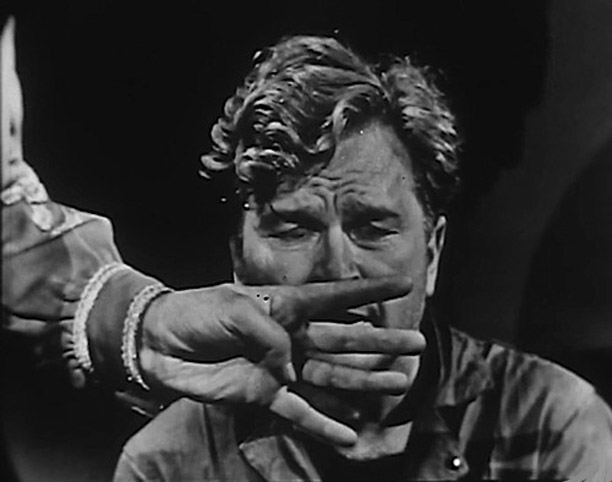
BBC broadcast December 12, 1954
The British Broadcasting Corporation (BBC) produced what is still considered by many reviewers as the best version of George Orwell's novel.
The teleplay was by BBC writer, Nigel Kneale, an excellent choice. Kneale may not be a known name to many American audiences, but in 1953 he created the character of Scientist "Professor Bernard Quatermass" and his "Rocket Group". Kneale would write both the BBC mini-series scripts. Then, for the House of Hammer, the shorten motion picture screenplays for "The Quatermass Experiment" turned into the Hammer film "The Quatermass X-periment (aka: The Creeping Unknown)", "Quatermass II" turned into the Hammer film under that title, but known in the United States as "Enemy from Space", "Quatermass and the Pitt" turned into the Hammer film of that name, but known in the United States as "Five Million Years to Earth". Nigel Kneale's other films included Hammer's "The Abominable Snowman (aka: The Abominable Snowman of the Himalayas)" and Ray Harryhausen's "First Men in the Moon".
Nigel Kneale's television script remains very faithful with Orwell's novel with a running time of one hour and forty-seven minutes. The BBC teleplay recreates exact scenes from the novel and uses George Orwell's own words throughout.
An example is the sequence in the pub, in the sector of "Airstrip One" for the "Pro's", the "Proletariat's", is extremely effective. As those "Pro's" in the pub realize that a member of the "Outer Party", "Winston Smith", is in their mist and both the class difference and the fear of what "Smith" stands for comes out. Especially when the teleplay has "Smith" speaking to an old man to find out, if he can tell him what life was like in England before "Big Brother".
The production was directed by Rudolph Cartier. He directed all three if those highly successful BBC mini-series Kneale wrote about "Professor Quatermass". Cartier directed for the BBC from 1932 through 1976.
When the program ran it apparently became extremely controversial. As many United Kingdom. viewers equated the themes to the current political scene in Britain and wrote letters raising questions to Parliament. In 2000 the British Film Institute ran a poll for the 100 Best U.K. Films ever and "1984" was 75th.

Above Peter Cushing as "Winston Smith" and Yvonne Mitchell as now "Julia Dixon". Cushing was three years away from first being associated with the "House of Hammer's" horror films with the "Curse of Frankenstein". Mitchell was first and foremost a stage actress, but appeared in British films over a 31 year period starting in 1941 in 38 different productions.
The role of "O'Brien" was portrayed by Andre Morell. Among his roles was the excellent BBC "Quatermass and the Pit" portraying "Bernard Quatermass", 1957's "The Bridge on the River Kwai" and in 1959, both, "Behemoth the Sea Monster" and as "Dr. Watson" in Hammer's "The Hound of the Baskervilles" opposite Peter Cushing's "Sherlock Holmes".
Below left to right, Mitchell, Cushing and Morell.

Donald Pleasence was "Syme" and I could hardly recognize this younger actor. In 1956 the actor became "Prince John" in television's "The Adventures of Robin Hood" starring Richard Greene. Pleasence was part of the all star cast of 1963's "The Great Escape", but it is his role as "Dr. Sam Loomis" in John Carpenter's 1978 "Halloween" that the actor is best known.

In the scene above "Winston" and "Syme" are at a local pub in the "Outer Party" section of "Airstrip One". Earlier in a canteen at their work. "Syme" gets excited telling the other man about how "Newspeak" will work. How the "Official Language" will shorten sentences and eliminate unnecessary words to control thought. "Winston" listening starts to quote "Hamlet's" soliloquy "To be, or not to be", but forgets the rest of the words. "Syme" tells him not to worry that soon "Shakespeare, Chaucer and other writers will be rewritten into the shorter, but better "Newspeak". As they finish their conversation "Syme" is arrested by the "Thought Police".
Below actor Leonard Sachs as "Mr. Carrington". His performance is "Chilling". He had been acting since 1938 and appeared on the BBC Science Fiction series "Dr. Who" with the First Doctor William Hartnell, then with Peter Davidson the Fifth Doctor and last appeared in 2015's "Doctor Who and the Time War". A feature film using archival footage of Tom Baker as the Fourth Doctor, Paul McGann as the Eighth Doctor and of Colin Baker, before he became the Sixth Doctor, as "Commander Maxill" in the Davidson series.

For a television production, at the time, the 1954 version of "1984" had an incredible 22 sets for a live broadcast. Some exterior scenes were shot on film and interspersed. Kneale's teleplay contained 22 roles adopted from the novel. Although the characters of "Katherine Smith", she is mentioned but not by name in passing, "Ampleforth", "Aaronson", "Jones" and "Rutherford" are left out.
Below "Winston Smith" in "R. Parson's" apartment, Left to right are Keith Davis as "Parson's Boy", Peter Cushing, Hilda Fenemore as "Mrs. Parsons" and Pamela Grant as "Parsons Girl".

When the broadcast showed the “Two Minute Hate”. The set was nothing more than two walls and some chairs to sit on. With the dark lighting and many close ups of the actors faces. The scene becomes very chilling as it shows the workers automatic fanatical response to the face of “Goldstein”. Then the euphoric reaction change of the same workers to just a picture of “Big Brother.
This production ends with "Winston" and "Julia", now looking older, from the torture they endured. They meet at a table in their workplace and confess that they betrayed "The Party" and each other.
As of this writing the production can be found on YouTube and is worth your time.
THE UNITED STATES AND UNITED KINGDOM CO-PRODUCTION released March 6, 1956
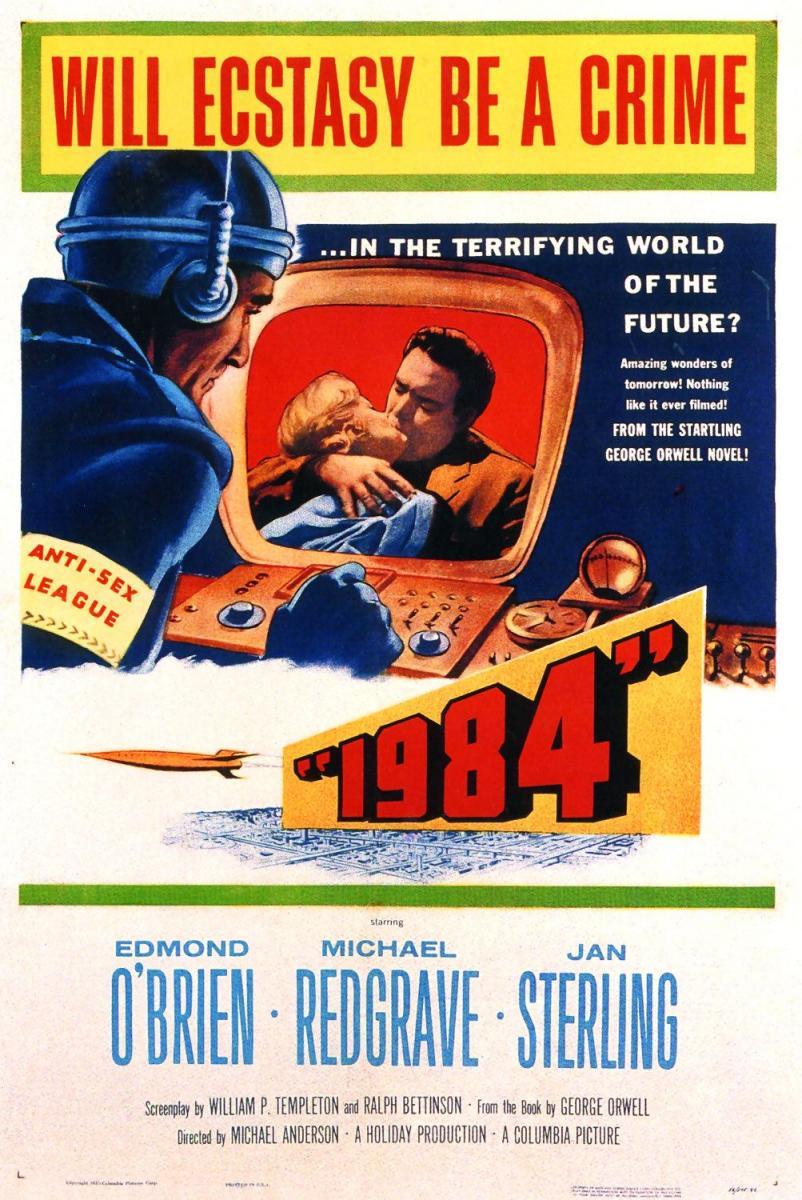
The first actual motion picture version of George Orwell's novel was a United States-British co-production. I was 9 years old when I saw it in 1956 on a double bill with another United States-British co-production entitled "The Gamma People". I admit "1984" was over my head and I preferred the other 1956 Science Fiction films like "Forbidden Planet", "It Conquered the World" and something called "Godzilla, King of the Monsters" with Raymond Burr. However, I also admit that when "1984" started showing up on television the film grew on me and led a Junior High School student to the novel.
The screenplay was once more written by writer William Pettigrew Templeton, American Ralph Gilbert Bettison was the co-screenplay writer and wrote 18 others mostly forgotten "B" movies.
The political slant to their screenplay came from the fact that the "Central Intelligence Agency (CIA)" funded most of this picture and influenced the subject matter and changes in Orwell's novel.
British director Michael Anderson was at the helm of this production. At this point in time Anderson had just directed the well-done World War 2 true story of the raid on the Ruhr Valley "The Dam Busters" starring Richard Todd and Michael Redgrave. Among Michael Anderson's future work would be 1956's "Around the World in 80 Days", the Gary Cooper and Charlton Heston 1959 "The Wreck of the Mary Deare", George Pal's 1975 "Doc Savage, the Man of Bronze" and 1976's "Logan's Run".
Two years prior to this film American character actor Edmond O'Brien, who would portray "Winston Smith", received the Academy Award for Best Supporting Actor for the Humphrey Bogart and Ava Gardner "The Barefoot Contessa". Among his 120 roles are 1964's "Seven Days in May" about a military take over of the United States, John Ford's 1962 "The Man Who Shot Liberty Valance" that starred John Wayne and James Stewart and Sam Peckinpah's 1969 "The Wild Bunch".
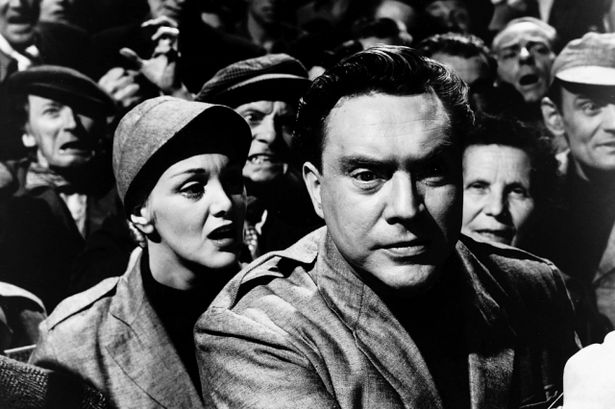
Michael Redgrave, the father of British actresses Vanessa and Lynn, was "General O'Connor". This was the character of "O'Brien", but the name was changed to stop any possible confusion with actor O'Brien. Redgrave besides appearing in 1955's "The Dam Busters" had starred in Alfred Hitchcock's 1938 "The Lady Vanishes", his first on screen role, his other British films included 1951's "The Browning Version", 1959's "The Wreck of the Mary Deare", 1962's "The Loneliness of the Long Distance Runner" and 1969's "The Battle of Britain".
George Orwell always told people that his novel "Nineteen Eighty-Four" wasn't really a look at the future year, but a look backward at those years just after World War 2. When the United Kingdom was recovering and the world he knew was bombed out buildings, cold winters and people starving.
During the publication month of June, 1949, in the world outside of Orwell's novel. The ships bringing good for the United Kingdom sat unloaded, because the dock workers were on strike. Their action forced the government to use the Military to unload them. In Europe Joseph Stalin was consolidating his power base and ruled the "Union of Soviet Socialist Republics" with an iron hand While in the United States "The Second Red Scare" had started. As American's pictured their neighbors as Communist agents and brought to power Senator Joseph McCarthy.

Fear versus reality became reflected in George Orwell's "1984". The World was ready to read into his novel what he wasn't speaking too.
The website "Goodreads" describes Orwell's novel this way:
Among the seminal texts of the 20th century, Nineteen Eighty-Four is a rare work that grows more haunting as its futuristic purgatory becomes more real. Published in 1949, the book offers political satirist George Orwell's nightmarish vision of a totalitarian, bureaucratic world and one poor stiff's attempt to find individuality. The brilliance of the novel is Orwell's prescience of modern life--the ubiquity of television, the distortion of the language--and his ability to construct such a thorough version of hell.https://www.goodreads.com/book/show/40961427-1984
George Orwell's World is now controlled by Three Superstates, "Oceania", "Eurasia" and "Eastasia", Orwell's spelling. The rest of the Earth is considered disputed lands. Below is a map showing the Earth of "Nineteen Eighty-Four".

Note that "Oceania" is constructed from both the North and South American continents, Australia, the British Isles and half of the African Continent. Although the novel and the film versions of it. All take place only in "Airstrip One" and the surrounding countryside.
While "Eurasia" is formed by the Soviet Union taking control of the rest of European Continent. "Eastasia" is under the control of China and consists also of Taiwan, Korea and Japan.
The disputed area is roughly the shape of a quadrilateral. Whose corners consist of the cities Tangier, Brazzaville, Darwin and Hong Kong. It is these areas that "The Perpetual War" is fought over and through the novel "Eastasia" consistently captures and then loses Indonesia, New Guinea and different islands of the Pacific Archipelago.
In many respects George Orwell projected the political goals of the then Soviet Union, mainland China and the United States and the United Kingdom into his future Earth. In fact as I write this article in 2019. The goals of Russia and China remain the same as Orwell envisioned them.
The main plot of "Nineteen Eighty-Four" takes place in the "Chief City" of "Airstrip One", London. There are no other "Capital's" since the "Revolution" following the nuclear war. "The Party" has consolidated their power base and eliminated Washington, D.C. in the old United States, Canberra in Australia and Ottawa in Canada.
Orwell's "Oceania" is a class society divided into three parts:
The "Inner Party" are the elite upper class ruling minority. In actuality they are only 2 percent of the total population.
The "Outer Party" are the middle class citizens, but they also only make up a mere 13 percent of the total population.
The "Proletariat" are the lower class and the remaining 85 percent of the population of "Oceania".
The population is controlled by "The Party" through four Ministries. Whose names are in the:
Political language designed to make lies sound truthfulThey are:
The "Ministry of Peace": Which actually makes war and is responsible for the defense of "Oceania".
The "Ministry of Plenty": Which deals with economic affairs. Making sure the "Inner Party" has all the food they want. This is accomplished by rationing the "Outer Party's" food and in many respects starving the "Proletariat". Today the announced increase in corn production over the last month is 20 percent, but tomorrow. The figure is "corrected" to 40 percent by the "Records Department". Illusion stops historical starvation should somebody re-read the history of "Oceania" under the benevolent "Big Brother".
The "Ministry of Love": which is the police force dealing with law and order. However, it is accomplished through torture and brainwashing.
The "Ministry of Truth: Which deals with news, entertainment and art. All through the controlled use of propaganda and changes by the "Records Department" as required..
Although the people of "Oceania" speak English.The official language is "Newspeak" and its purpose is found at "newspeak.com":
The purpose of Newspeak was not only to provide a medium of expression for the world-view and mental habits proper to the devotees of Ingsoc, but to make all other modes of thought impossible. Its vocabulary was so constructed as to give exact and often very subtle expression to every meaning that a Party member could properly wish to express, while excluding all other meaning and also the possibility of arriving at them by indirect methods. This was done partly by the invention of new words, but chiefly by eliminating undesirable words and stripping such words as remained of unorthodox meanings, and so far as possible of all secondary meaning whateverThe head of the "The Party" is "Big Brother" and his followers are part of a "Cult of Personality". Merriam-Webster defined the term as:
a situation in which a public figure (such as a political leader) is deliberately presented to the people of a country as a great person who should be admired and lovedIn the case of Orwell's novel, Unlike real tyrants like Julius Caesar, Napoleon Bonaparte, Adolph Hitler, or Joseph Stalin. "Big Brother" never existed and is the creation of the "Inner Party". Though this original illustration of the "Oceania's" leader is telling:

It is the "Inner Party", through the four Ministries and their creation, that keeps the other 98 percent of "Oceania's" population fanatically believing and crying out:
Long Live Big Brotherand remembering the three principles:
War is peace. Freedom is slavery. Ignorance is strength.George Orwell's three main characters are:
"Winston Smith": Orwell's middle class "Every Man", working in the "Records Department" of "The Ministry of Truth". He rewrites historical records to confirm to the current set of alternative facts supplied to him by his superiors. Problem arise when "Smith" starts to question what he writes and wonders what the World was like before "The Revolution".
"Julia": Who becomes "Winston's" lover. Her position in "The Ministry of Truth" is to maintain the "Novel writing machines". Machines that either rewrite established novels to conform to the propaganda of the "Inner Party", or new ones. She publicly is an active member of the fantastical "Anti-Sex League".
"O'Brien": Who poses as a member of the "Brotherhood". A counter revolutionary group, "O'Brien" is in reality a member of the "Inner Party" attempting to trap "Winston" and "Julia". Then re-educate them through "The Ministry of Love".
There are several Secondary characters in the novel, but the following are considered the main ones by reviewers:
"Mr. Carrington": The kindly shop keeper. Who is in reality an agent of the "Thought Police", the "Secret Police", who discover and punish those committing "Thoughtcrime". Basically thinking as an "Individual" and becoming a danger to the totalitarian regime of "Oceania".
"Syme": A co-worker of "Smith's" and one of the developers of the language called "Newspeak".
"Katharine Smith": The wife of "Winston". She cannot have children and he cannot, under the law, divorce her, but they now live separate lives. The two originally married because of "duty to the party" and "Katharine" was and still is a "goodthinkfull", another Orwellian term, of the party.
"Ampleforth": He was "Winston's" one time "Records Department" co-worker, "Ampleforth" was imprisoned for a time, because he said the word "GOD",
"Aaronson", "Jones" and "Rutherford" are former members of the "Inner Party". "Winston" has a vague memory that they were the original leaders of the "Revolution".
'Parsons": A fat and obnoxious Party member who lives with his family in the same apartment house as "Smith". "Parsons" has a perfectly dull "Party: wife and two children.
His daughter is a fanatical follower of "Big Brother" and the perfect example of a childhood that only knows a totalitarian regime. She is a member of the "SPYS", think totalitarian Girl Scouts, and proud to have got a man with "Odd Looking Shoes" arrested by the "Thought Police". The son is not anything like his sister and might even be considered attempting to be a normal boy.
Another character not physically seen in the novel is "Emmanuel Goldstein". He was once a leading figure in "The Party" and became the leader of the opposition to "Big Brother". "Goldstein" is the embodiment of "The Enemy" the people of "Oceania" are fighting.
Everyday "The Party", all over "Oceania", conducts the "Two Minute Hate". Which shows a photo of "Emmanuel Goldstein", the only way anyone knows he exists, and shows a nondescript soldier shooting a machine gun at the audience. Every citizen of "Oceania", at least in the "Inner" and "Outer" parties is driven into a frenzy of hate against "Goldstein".
The "Two Minute Hate" is broadcast over a "Telescreen". These two-way screens are even in people's homes in every living space. They bring the propaganda passed off as news and watch the occupants every action and listen to their every thought. "BIG BROTHER IS WATCHING!".
The novel follows "Winston" and "Julia" as they fall in love and become lovers."Winston" is convinced that "O'Brien" is a member of the "Brotherhood", but this is false. The hide away used by the two lovers located upstairs in "Mr. Carrington's" shop is a trap with a hidden "Telescreen". They are arrested and taken to the "Ministry of Love" and are tortured into becoming model members of the "Outer Party". They meet once and admit their betrayal to each other.
In the end "Winston Smith" returns to the "Chestnut Tree Cafe", finds a table with a chess board, and is sitting at it drinking "Victory Gin". He then experiences several "memories" of his childhood, but is it a false memory as he has been "trained" to have no other thoughts than those of "The Party" and "Love for Big Brother".
He hears an announcement of an "Oceania" victory in Africa and silently rejoices. Then slips back into a dream and in George Orwell's words:
He is back in the Ministry of Love, with everything forgiven, his soul white as snow. He was in the public dock , confessing everything, implicating everyone. He was walking upon the white-tiled corridor, with the feeling of walking in sunlight, and an armed guard at his back. The long hoped-for bullet was entering his head.This is not real, but a metaphor for the man that once was "Winston Smith" murdered by "O'Brien", "Mr. Charington" and "The Party".
THE MOTION PICTURES AND TELEVISION VERSIONS OF THE NOVEL
STUDIO ONE September 21, 1953
The first version of George Orwell's novel was on the Columbia Broadcasting System (CBS) live television anthology series "Studio One".


This production had a running time just under 50 minutes and was written by Scottish writer William Pettigrew Templeton. Templeton wrote the still excellent murder mystery movie from 1948 "The Fallen Idol", but otherwise he worked for both British and American television.
William Templeton's script gets the basic story down, but falls short mainly because of the amount of time he's given. Additionally the acting is stiff, but this was still early American television and some of the actor's were just learning their trade. There was a 2002 DVD release of the program, if my reader can locate it.
The director was Paul Nickell who worked from 1949 through 1966 on American television shows. Including "Lassie", "Bonanza" and "The Farmer's Daughter".
The cast included:
Eddie Albert as "Winston Smith". Albert was in the first experimental television broadcast by the National Broadcasting Company (NBC) in 1936. Over his career he appeared in 204 roles including the popular television show "Green Acres" with co star Eva Gabor. Albert was the warden in the original 1974 "The Longest Yard" starring Burt Reynolds and co-starred with Gregory Peck and Audrey Hepburn in 1953 "Roman Holiday". Albert is in the center of the above still.
Norma Crane portrayed "Julia". Crane's career was mostly on television, but she was the mother "Golde", in the motion picture version of "Fiddler on the Roof". Crane is just to the left of Albert in the above still.
Lorne Greene portrayed "O'Brien". Six years after this production the television and motion picture character actor became "Ben Cartwright" on televisions "Bonanza" for the next fourteen years.


BBC broadcast December 12, 1954
The British Broadcasting Corporation (BBC) produced what is still considered by many reviewers as the best version of George Orwell's novel.
The teleplay was by BBC writer, Nigel Kneale, an excellent choice. Kneale may not be a known name to many American audiences, but in 1953 he created the character of Scientist "Professor Bernard Quatermass" and his "Rocket Group". Kneale would write both the BBC mini-series scripts. Then, for the House of Hammer, the shorten motion picture screenplays for "The Quatermass Experiment" turned into the Hammer film "The Quatermass X-periment (aka: The Creeping Unknown)", "Quatermass II" turned into the Hammer film under that title, but known in the United States as "Enemy from Space", "Quatermass and the Pitt" turned into the Hammer film of that name, but known in the United States as "Five Million Years to Earth". Nigel Kneale's other films included Hammer's "The Abominable Snowman (aka: The Abominable Snowman of the Himalayas)" and Ray Harryhausen's "First Men in the Moon".
Nigel Kneale's television script remains very faithful with Orwell's novel with a running time of one hour and forty-seven minutes. The BBC teleplay recreates exact scenes from the novel and uses George Orwell's own words throughout.
An example is the sequence in the pub, in the sector of "Airstrip One" for the "Pro's", the "Proletariat's", is extremely effective. As those "Pro's" in the pub realize that a member of the "Outer Party", "Winston Smith", is in their mist and both the class difference and the fear of what "Smith" stands for comes out. Especially when the teleplay has "Smith" speaking to an old man to find out, if he can tell him what life was like in England before "Big Brother".
The production was directed by Rudolph Cartier. He directed all three if those highly successful BBC mini-series Kneale wrote about "Professor Quatermass". Cartier directed for the BBC from 1932 through 1976.
When the program ran it apparently became extremely controversial. As many United Kingdom. viewers equated the themes to the current political scene in Britain and wrote letters raising questions to Parliament. In 2000 the British Film Institute ran a poll for the 100 Best U.K. Films ever and "1984" was 75th.

Above Peter Cushing as "Winston Smith" and Yvonne Mitchell as now "Julia Dixon". Cushing was three years away from first being associated with the "House of Hammer's" horror films with the "Curse of Frankenstein". Mitchell was first and foremost a stage actress, but appeared in British films over a 31 year period starting in 1941 in 38 different productions.
The role of "O'Brien" was portrayed by Andre Morell. Among his roles was the excellent BBC "Quatermass and the Pit" portraying "Bernard Quatermass", 1957's "The Bridge on the River Kwai" and in 1959, both, "Behemoth the Sea Monster" and as "Dr. Watson" in Hammer's "The Hound of the Baskervilles" opposite Peter Cushing's "Sherlock Holmes".
Below left to right, Mitchell, Cushing and Morell.

Donald Pleasence was "Syme" and I could hardly recognize this younger actor. In 1956 the actor became "Prince John" in television's "The Adventures of Robin Hood" starring Richard Greene. Pleasence was part of the all star cast of 1963's "The Great Escape", but it is his role as "Dr. Sam Loomis" in John Carpenter's 1978 "Halloween" that the actor is best known.

In the scene above "Winston" and "Syme" are at a local pub in the "Outer Party" section of "Airstrip One". Earlier in a canteen at their work. "Syme" gets excited telling the other man about how "Newspeak" will work. How the "Official Language" will shorten sentences and eliminate unnecessary words to control thought. "Winston" listening starts to quote "Hamlet's" soliloquy "To be, or not to be", but forgets the rest of the words. "Syme" tells him not to worry that soon "Shakespeare, Chaucer and other writers will be rewritten into the shorter, but better "Newspeak". As they finish their conversation "Syme" is arrested by the "Thought Police".
Below actor Leonard Sachs as "Mr. Carrington". His performance is "Chilling". He had been acting since 1938 and appeared on the BBC Science Fiction series "Dr. Who" with the First Doctor William Hartnell, then with Peter Davidson the Fifth Doctor and last appeared in 2015's "Doctor Who and the Time War". A feature film using archival footage of Tom Baker as the Fourth Doctor, Paul McGann as the Eighth Doctor and of Colin Baker, before he became the Sixth Doctor, as "Commander Maxill" in the Davidson series.

For a television production, at the time, the 1954 version of "1984" had an incredible 22 sets for a live broadcast. Some exterior scenes were shot on film and interspersed. Kneale's teleplay contained 22 roles adopted from the novel. Although the characters of "Katherine Smith", she is mentioned but not by name in passing, "Ampleforth", "Aaronson", "Jones" and "Rutherford" are left out.
Below "Winston Smith" in "R. Parson's" apartment, Left to right are Keith Davis as "Parson's Boy", Peter Cushing, Hilda Fenemore as "Mrs. Parsons" and Pamela Grant as "Parsons Girl".

The broadcast was the
most expensive British television program to date and a good portion went to
those sets. Two examples of how those sets worked are in “Winston Smith’s”
apartment. The outside of the apartment house looks rotten and falling
apart. It was a real building in London in 1954. His walls are covered in cheap
wallpaper starting to peel. The quickly built set adds to the
atmosphere of a world were even the “Outer Party” just lives in a higher form of
poverty than the “Proletariat”. In his apartment “Winston” has added a fake wall to hide a desk
from the telescreen. That desk contains a diary with entries against “Big
Brother”.
When the broadcast showed the “Two Minute Hate”. The set was nothing more than two walls and some chairs to sit on. With the dark lighting and many close ups of the actors faces. The scene becomes very chilling as it shows the workers automatic fanatical response to the face of “Goldstein”. Then the euphoric reaction change of the same workers to just a picture of “Big Brother.
This production ends with "Winston" and "Julia", now looking older, from the torture they endured. They meet at a table in their workplace and confess that they betrayed "The Party" and each other.
Below a still of the shooting of a scene to use in the live broadcast.


As of this writing the production can be found on YouTube and is worth your time.
THE UNITED STATES AND UNITED KINGDOM CO-PRODUCTION released March 6, 1956

The first actual motion picture version of George Orwell's novel was a United States-British co-production. I was 9 years old when I saw it in 1956 on a double bill with another United States-British co-production entitled "The Gamma People". I admit "1984" was over my head and I preferred the other 1956 Science Fiction films like "Forbidden Planet", "It Conquered the World" and something called "Godzilla, King of the Monsters" with Raymond Burr. However, I also admit that when "1984" started showing up on television the film grew on me and led a Junior High School student to the novel.
The screenplay was once more written by writer William Pettigrew Templeton, American Ralph Gilbert Bettison was the co-screenplay writer and wrote 18 others mostly forgotten "B" movies.
The political slant to their screenplay came from the fact that the "Central Intelligence Agency (CIA)" funded most of this picture and influenced the subject matter and changes in Orwell's novel.
British director Michael Anderson was at the helm of this production. At this point in time Anderson had just directed the well-done World War 2 true story of the raid on the Ruhr Valley "The Dam Busters" starring Richard Todd and Michael Redgrave. Among Michael Anderson's future work would be 1956's "Around the World in 80 Days", the Gary Cooper and Charlton Heston 1959 "The Wreck of the Mary Deare", George Pal's 1975 "Doc Savage, the Man of Bronze" and 1976's "Logan's Run".
Two years prior to this film American character actor Edmond O'Brien, who would portray "Winston Smith", received the Academy Award for Best Supporting Actor for the Humphrey Bogart and Ava Gardner "The Barefoot Contessa". Among his 120 roles are 1964's "Seven Days in May" about a military take over of the United States, John Ford's 1962 "The Man Who Shot Liberty Valance" that starred John Wayne and James Stewart and Sam Peckinpah's 1969 "The Wild Bunch".

Michael Redgrave, the father of British actresses Vanessa and Lynn, was "General O'Connor". This was the character of "O'Brien", but the name was changed to stop any possible confusion with actor O'Brien. Redgrave besides appearing in 1955's "The Dam Busters" had starred in Alfred Hitchcock's 1938 "The Lady Vanishes", his first on screen role, his other British films included 1951's "The Browning Version", 1959's "The Wreck of the Mary Deare", 1962's "The Loneliness of the Long Distance Runner" and 1969's "The Battle of Britain".


American actress Jan Sterling was "Julia". Sterling had won the Golden Globe and was nominated for the Oscar as Best Supporting actress for 1954's "The High and the Mighty". She had also co-starred with Kirk Douglas in 1951's "Ace in the Hole" and co-starred with Charlton Heston and Rhonda Fleming in 1953's "Pony Express".

Actor David Kossoff was "Charington". Kossoff would be in a memorable British political satire 1959's "The Mouse the Roared" starring Peter Sellers in multiple roles. It was about the tiny, backward, "Grand Duchy of Fenwick," that declares war upon the modern United States to lose and get aide but wins instead. Kossoff was in the sequel 1963's "The Mouse That Roared" about the "Duchy" beating both the U.K. and the United States to the moon. Rossoff was the evil "Sheriff of Nottingham" in the 1953 mini-series "The Adventures of Robin Hood" starring the future second "Dr. Who" Patrick Troughton.
Although the feature has 21 listed actors. Only four other roles from the list of characters in the novel are included beyond the above four.
We have "R. Parsons", but without his wife. Although he has two children. The role of "R. Parsons" is portrayed by Donald Pleasence. His daughter "Selina" was portrayed by Carol Woveridge. Her screen acting career was mostly British television for 19 roles between 1951 and 1960.
Below left to right, Pleasence, Woveridge and O'Brien
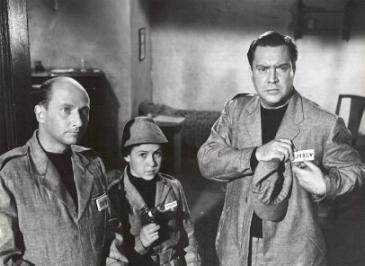
"Rutherford" was portrayed by Canadian actor Ronan O'Casey. O'Casey portrayed a "reporter' in the anti-Nuclear weapons British Science Fiction picture 1956's "Satlellite in the Sky". That feature starred Kieron Mathews and a pre-"Moneypenny" Lois Maxwell. Ronan O'Casey was also in the British 1956 mini-series "The Trollenberg Terror". Which became a 1958 feature film of that name in the U.K. and was known as "The Crawling Eye" in the United States.
Between the Cinematography of C.M. Pennington-Richards and the stark sets of Terence Variety. The film evokes the pure depression and claustrophobia of a totalitarian government.

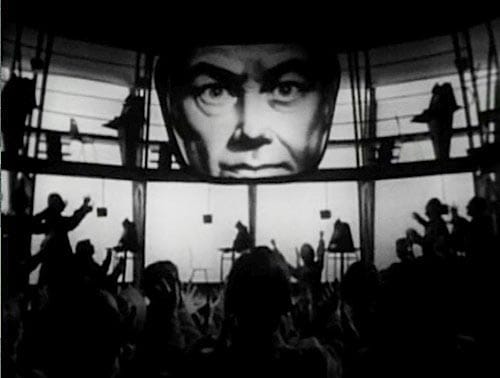
NINETEEN EIGHTY-FOUR aka: 1984 released October 10, 1984
This entry from the United Kingdom was released in 1984 and was the first on screen version of George Orwell's novel in twenty-eight years.
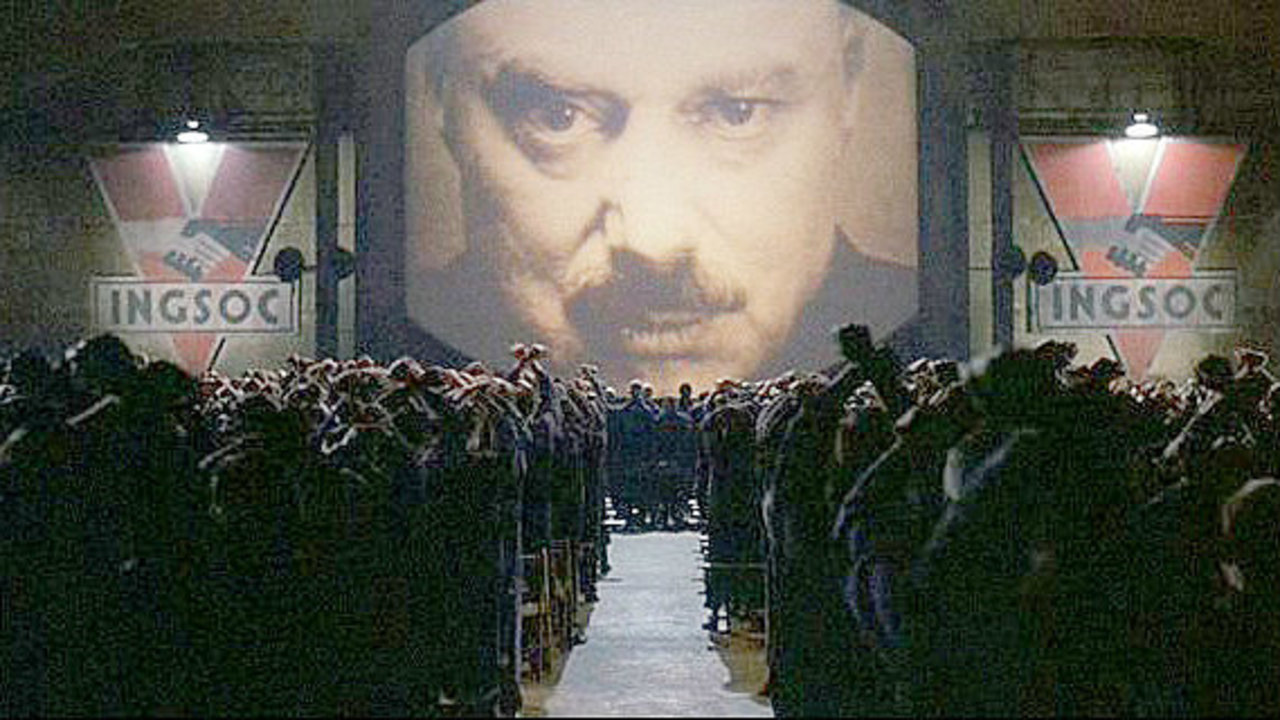
The screenplay was written by the motion picture's director Michael Radford. To date Radford has 19 directing credits. Two of which are documentaries "Van Morrison in Ireland" in 1980 and 1982's "The Making of the Pirates of Penzance" a short subject. Michael Radford directed the 2004 Al Pacino and Jeremy Irons film of William Shakespeare's "The Merchant of Venice" and is currently in pre-production of another Shakespeare story with Pacino "King Lear". Including "1984" Radford has written fourteen other features. They include the two Italian features "Il Postino (The Postman)" in 1994 and 2013's "La mula (The Mule)".
In Michael Radford's vision "Winston Smith" is portrayed by John Hurt. Can anyone that saw the movie forget the "Alien" coming out of Hurt's stomach in the 1979 motion picture? John Hurt had another distinction of portraying "The War Doctor" on the BBC series "Dr. Who". A version of the "Timelord" who comes between the 8th and 9th Doctors and is a forced regeneration of the 8th. Another very strong performance by the actor was in 1980's "The Elephant Man" in which he portrayed the real life John Merrick.
Richard Burton portrayed "O'Brien". The distinguished actor of 1953's "The Desert Rats", 1956's "Alexander the Great", 1959's "Look Back in Anger", 1964's "Becket" opposite Peter O'Toole and the same years "The Night of the Iguana" with Ava Gardner and Deborah Kerr. Along with the excellent 1965 "The Spy Who Came in From the Cold" was not the first actor for the role of "O'Brien".
Actor Paul Scofield was cast as "O'Brien", but broke his leg before shooting began. In order the role was offered too Anthony Hopkins, Sean Connery and Rod Steiger, but for one reason or another they could not do it. So Richard Burton was approached and agreed as long as his costumes were hand made by a specific tailor in Savile Row, London.

Suzanna Hamilton became "Julia". Although she had been acting since 1972 between feature films and British television. This was Suzanna Hamilton's first major role. The actress returned to British television and in 2007 portrayed "Dr. Hillary Slaton" in eleven episodes of the television series "Dinosapien".
Irish movie and television actor Cyril Cusack was "Mr. Charington". Among his work is the 1966 motion picture version of Ray Btadbury's "Fahrenheit 451", the 1967 Richard Burton and Elizabeth Taylor "The Taming of the Shrew" and 1973's original "The Day of the Jackal".

Besides the characters of "Syme","Parsons" and his wife and daughter.The motion picture does include the characters of "Rutherford", "Jones", "Winston's" wife, his mother, sister, and a young "Winston Smith". Along with "Goldstein",
Michael Radford's screenplay becomes more ambitious than the proceeding three 1950's productions and the final film runs one hour and fifty-three minutes. This is the only version of George Orwell's novel to include "Winston's" dreams of murdering his mother, A fact that in the novel is never made conclusive he did such an act. Both "Winston Smith's" mother and sister just disappeared when he was young.

The film has a double ending. "Winston" is back at the "Chestnut Tree Cafe" after being "rehabilitated" and is approached by "Julia". The two share a glass of "Victory Gin" and mention how they each betrayed the other. She leaves and "Winston" see a picture of himself confessing his crimes and asking for forgiveness. As in the three previous features.
Still sitting at the table, he sees a picture of "Big Brother" appear on the telescreen and hears about a major victory in North Africa against "Eurasia". "Winston" looks at the picture of "Big Brother" and gets up to leave with tears in his eyes.

1984 THE OPERA premiered May 3, 2005
You're reading correctly. George Orwell's novel was turned into a full opera.
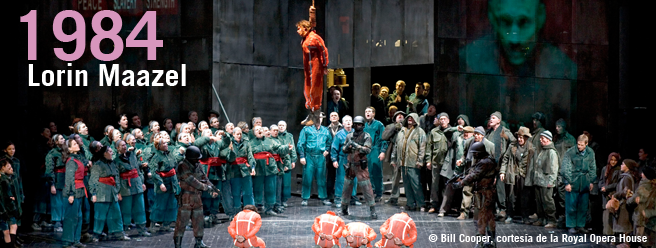
Composer Lorin Maazel's opera opened at the Royal Opera House, in London.
Sir Simon Keenltside, a baritone, sang the part of "Winston".
Nancy Gustafson, a soprano, sang the part of "Julia".
Richard Margison, a tenor, sang the part of "O'Brien".
The reviews of the opera in the British Press were negative.


1984 THE PLAY premiered September 13, 2013
The play was written by Robert Icke and Duncan Macmillan and premiered at the Notthingham Playhouse, in Nottingham, England. The Broadway production would be nominated for three 2018 Tony Awards.

There was a version of the play that featured John Hurt. Below is a rehearsal still.
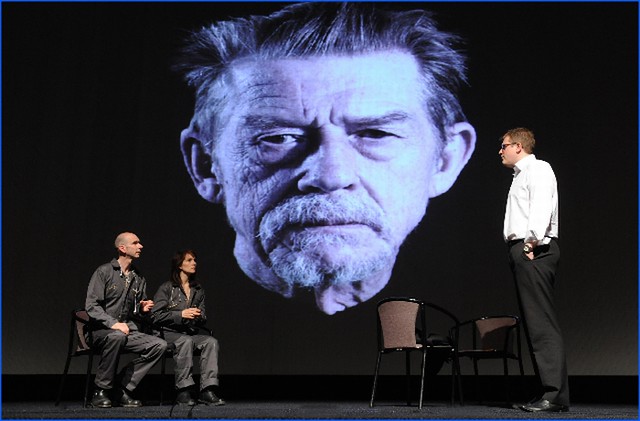
ANIMAL FARM A FAIRY STORY
Below is the cover of the first edition of George Orwell's "Animal Farm" published in England on August 17, 1945.
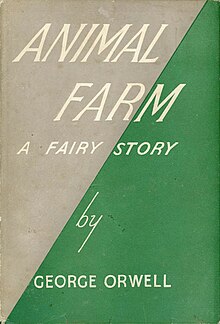
"Animal Farm A Fairy Story" is the original title of George Orwell's work. The "A Fairy Story" was dropped by the United States publisher to just "Animal Farm" and all other editions, Worldwide, adapted that shorter title including the second printing in the U.K.
Orwell was a critic of Joseph Stalin and Stalinism. Which was implemented in 1927 and first encountered by the author during his time observing the Spanish Civil War of 1936 through 1939.
To the Democratic Socialist George Orwell. Whose political philosophy was advocating democracy with social ownership as a means of production through self and democratic management. Joseph Stalin had taken the bright future of the Russian Revolution of Marx, Lenin and Trotsky and turned it into a Brutal Dictatorship, based once again, on a "Cult of Personality".
According to Orwell in the "Preface" to the 1947 Ukrainian edition of "Animal Farm". The author explained that at the time he left the Spanish Civil War during the Communist purges. He had learned:
The Pigs:
"Old Major" is the allegorical Karl Marx and Vladimir Lenin.
"Napoleon" is the allegorical Joseph Stalin.
"Snowball" is the rival of "Napoleon" and is the allegorical Leon Trotsky figure.
"Squealer" is the allegorical Vyacheslav Molotov.
The Humans:
"Mr. Jones" is the allegorical Czar Nicholas II.
"Mr. Frederick" is the owner of another farm next to "Manor Farm". He will lead an attack of humans on what is now "Animal Farm". From a political point of view. His actions and the aftermath might historically be compared to the "Molotov-Ribbentrop Pact" between Russia and Germany and later "Operation Barbossa". Should my reader want to look this up.
The Horses and the Donkeys
"Boxar (Boxer)" the horse has been compared to a representation of Alexey Stakhabnov. Whose workers movement took pride in turning out more than was required and expected.
"Benjamin" the donkey is one of the oldest and wisest of all the Farm's animals.
The plot of the novel, in itself, is simple. The "Farm" initially becomes Orwell's allegorical Russia on October 26, 1917, the date of the "Russian Revolution", as the Pigs lead by, "Old Major", overthrow "Farmer Jones'".perceived cruel rule.
There are Seven Commandments for the Farm Animals to Follow set up by "Old Major":
1. Whatever goes upon two legs is the enemy.
2. Whatever goes upon four legs, or his wings, is a friend.
3. No Animal shall wear clothes.
4. No Animal shall sleep in a bed.
5. No Animal shall drink alcohol.
6. No Animal shall kill any other animal.
7. All Animals are equal.
As the story progresses the class structure of Russia becomes clear with the Pigs at the top of the Farm Animals. "Old Major", who is expounding a Marxist form of government, is accidentally killed by a drunken "Farmer Jones" with a shotgun. This leads to "Napoleon's" rise to power and the establishment of Joseph Stalin's Soviet Communism.
Time progress as "Napoleon" and the pigs become more human like and by George Orwell's "A Fairy Story" ending. Those Seven Commandments had been merged into two:
1. All Animals are equal, but some Animals are more equal than others.
2. Four legs good, Two legs better.
"Napoleon" and his followers, including the young piglets now being the first generation raised under the Communist system, walk on two legs, wear clothing and sleep in beds. "Napoleon" has made alliances with the human farmers and Stalin's Soviet Union has truly been created.
The novel ends with an allusion to the 1943 "Tehran Conference" meeting between Stalin, Roosevelt and Churchill, The other animals see "Napoleon", at a card game with other pigs and human farmers. "Napoleon" states the animals goal now is:
ANIMAL FARM ON FILM
There have been, to date, only two film versions of George Orwell's novel.
UNITED KINGDOM AND UNITED STATES CO-PRODUCTION released December 29, 1954
The poster for the first commercial British animated motion picture. Seems to give the potential audience the illusion the film was comedy. In fact it was described as a comedy-drama.
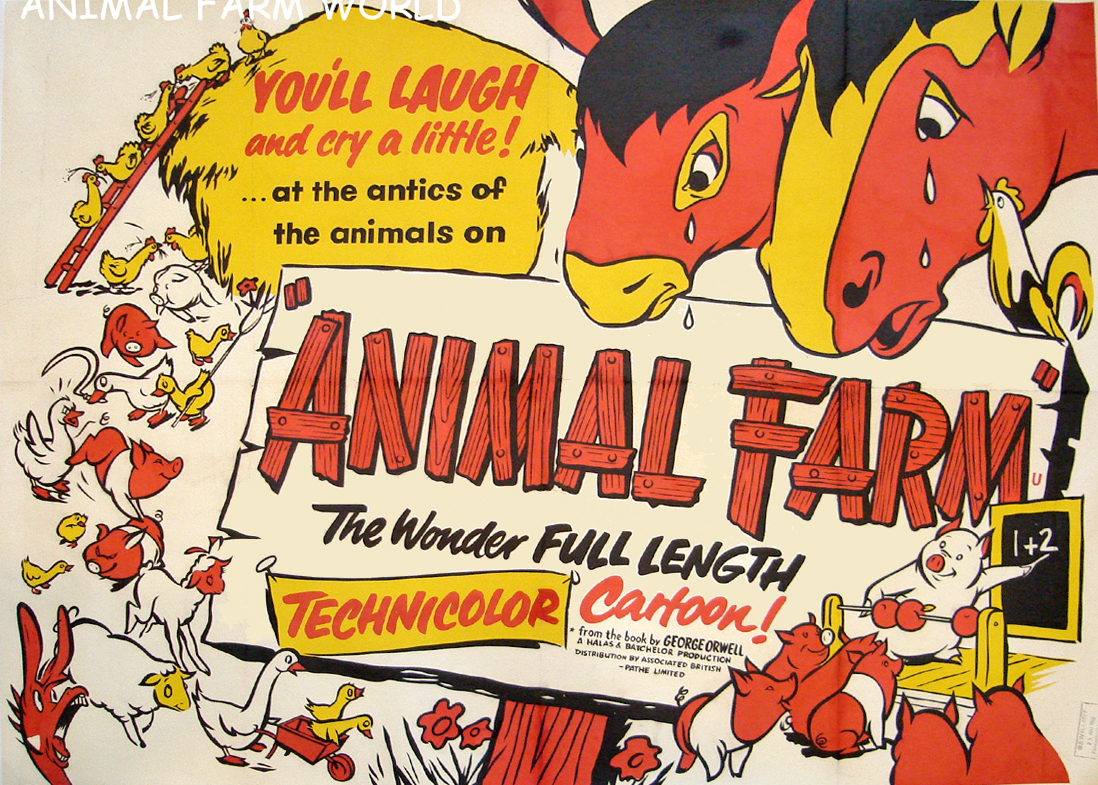
There were six writers on the project, BUT the funding came from the United States. More specifically the "Central Intelligence Agency (CIA)" who controlled the actual story line. Technically the animated feature was produced by Hungarian animator John Halas and English animator Joy Batchelor, but this was a CIA operation as was the 1956 "1984" all the way.
Animation historian Brian Sibleyon the 2008 "Special Edition DVD" of the film expressed his view that neither Halas, or Batchelor were aware of the source of the funding for the feature.
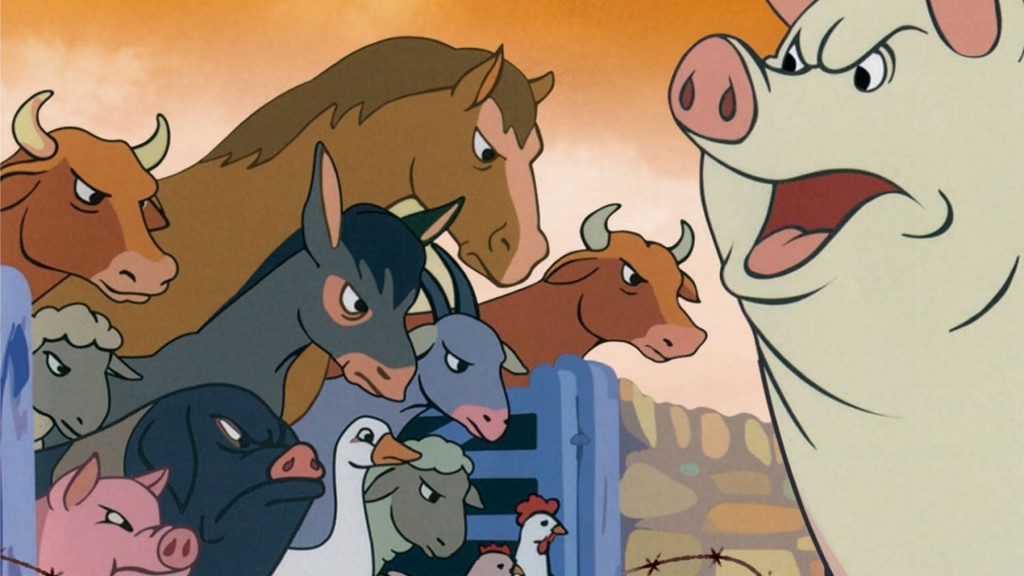


Th ending of this feature is changed and has the CIA influence at its peak. Instead of the one from the novel above: The donkey "Benjamin" overhears a conversation between"Napoleon" and pigs from other farms. "Napoleon" gives a toast stating that it is his hope, Stalin on Communism, that pigs everywhere in the world will control farms like this one.
Realizing the potential danger to freedom of animals everywhere. The good wise donkey "Benjamin" organizes a revolt to avenge the deaths of "Snowball", "Boxer" and their other animal compatriots that have been murdered by "Napoleon". "Napoleon" is cornered, his guard dogs are drunk and cannot aide him, and the other pigs are too frightened to fight. "Napoleon" is overrun by the animals and dies. Communism is dead and Democracy has been restored!
Also in 1954 Harold Whitaker, one of the British animators, turned the film into a weekly newspaper comic strip.
HALLMARK FILMS PRODUCTION
This made for television production appeared on both "Turner Network Television (TNT)" and the "Hallmark Channel" on October 3, 1999. This was also a United States and United Kingdom co-production, but without CIA funding.

The production used a combination of live actors, CGI and puppets. "Jim Henson's Creature Shop" built four pigs ("Napoleon", "Old Major", "Snowball" and "Squealer"), two horses ("Boxer" and "Mollie"), a sheepdog ("Jessie"), a donkey ("Benjamin"), a raven ("Moses"), a goat ("Muriel") and assorted other animals.

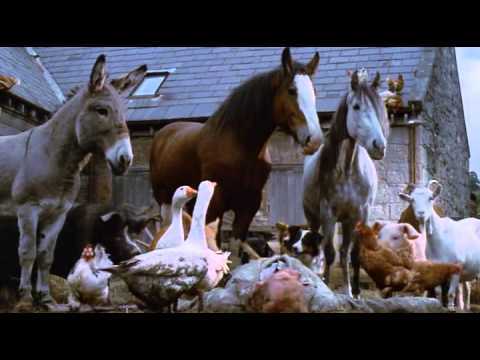

Here are some of the voice cast and the descriptions given by British television story writer Alan Janes of their characters.
Julia Ormand is "Jessie" a wise old border collie
Patrick Stewart as "Napoleon".the leader of the pigs.
Peter Ustinov as "Old Major" the former leader of the pigs.
Kelsey Grammer as "Snowball" a pig driven into exile by "Napoleon".
Ian Holm as "Squealer" the second in-command pig.
Paul Scofield as "Boxar" a Shire Horse who is made into clue.
Pete Postlethwaite as "Benjamin" an old donkey The actor was also seen as "Mr. Jones".
Alan Janes' story and the teleplay by Martyn Burke move the character of the female border collie "Jessie" to the forefront. As the story opens on a bleak scene of farm animals struggling in the remains of a farm. Enter "Jessie", who through a flashback, narrates the story of "Animal Farm".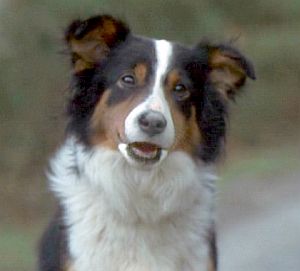
George Orwell's basic story is followed, but there are some changes that critics of the picture objected too. Especially the ending which is in two parts. The first has "Napoleon" appear on two legs wearing clothing and "Benjamin" and "Muriel" noticing that the final commandment now reads:
The second part is the end pf the flashback as the audience sees "Jessie' return to an unattended farm in ruins. All the animals involved in the story have died, but then she notices some puppies and realizes that they're hers taken by "Napoleon" earlier in the film. She also has noticed the statue of "Napoleon" once raised in glory is now broken. A car arrives and the new owners of "Manor Farm" arrive and the film ends as "Jessie" hopes that things can now be better.
Two novels still read today. Although mostly in English literature classes. Both still have aspects that reflect the world I live in today and perhaps, unintentionally, still a warning from their author ERIC ARTHUR BLAIR.
.


I mentioned the CIA was involved in this screenplay. Here, the geopolitical situation of the time, becomes fact and fits George Orwell's intent. The feature opens with a narrator telling the audience that in the mid 1950's there was a nuclear war. Out of the ashes, radiation is never addressed, rose three superstates. They are "Oceania" ruled by the never seen "Big Brother". "Eurasia" ruled by the Soviet Union and by inference Stalin, and "East Asia" ruled by a sub-branch of Socialists. Not the Chinese of Orwell's novel.
Even though the United States and the U.K. had just fought the Chinese during the "Korean War". This change in story came from the C.I.A., because the Chinese were racially looked upon, as inferior and incapable of ruling a society as Orwell wrote it in a "White" world.
Obviously, not one member of the CIA ever read the 1929 novel, "Warlords of Han", by Philip Francis Nowlan. In which, Nowlan uses his hero, "Anthony Rodgers", from his 1928 novel, "Armageddon 2419 A.D.", before the author renamed him "Buck Rodgers" for the comic strip he started to write. In the sequel, "Anthony" and others are still fighting the evil "Hans (Chinese)". While, the entire world is now controlled by them, not by the utilization of weapons and armies, but by controlling the world's businesses and trade. In the "Han" home country, citizens have their pay automatically sent to their banks. Then, they use a small desk top machine to order merchandise and food, or communicate to each other. The cost of which, is automatically deducted from their bank accounts and the companies the items were bought from deliver it to the appropriate residence without charge. Also, Philip Francis Nowlan's "Hans" can speak to and see other people on a flat screen on a well in either their home, or place of work. The screen also shows movies, the latest news, and interesting programing for relaxation, or business.
The capital of "Oceania" is still "Airstrip One" located in London, England. The screenplay explains this was chosen, because the British Parliament had an Atomic Bomb proof shelter and they were the only governing group to survive outside of the Kremlin. Washington, D.C. apparently was totally destroyed and did not have an Atomic Bomb shelter for the President that worked.
This film is criticized by some and praised by others. The running time of the final print was 90 minutes.
One has to approach the screenplay not as what George Orwell wrote in 1949, but what his thinking might be had he been alive in 1956 and wrote "1984".
NINETEEN EIGHTY-FOUR aka: 1984 released October 10, 1984
This entry from the United Kingdom was released in 1984 and was the first on screen version of George Orwell's novel in twenty-eight years.

The screenplay was written by the motion picture's director Michael Radford. To date Radford has 19 directing credits. Two of which are documentaries "Van Morrison in Ireland" in 1980 and 1982's "The Making of the Pirates of Penzance" a short subject. Michael Radford directed the 2004 Al Pacino and Jeremy Irons film of William Shakespeare's "The Merchant of Venice" and is currently in pre-production of another Shakespeare story with Pacino "King Lear". Including "1984" Radford has written fourteen other features. They include the two Italian features "Il Postino (The Postman)" in 1994 and 2013's "La mula (The Mule)".
In Michael Radford's vision "Winston Smith" is portrayed by John Hurt. Can anyone that saw the movie forget the "Alien" coming out of Hurt's stomach in the 1979 motion picture? John Hurt had another distinction of portraying "The War Doctor" on the BBC series "Dr. Who". A version of the "Timelord" who comes between the 8th and 9th Doctors and is a forced regeneration of the 8th. Another very strong performance by the actor was in 1980's "The Elephant Man" in which he portrayed the real life John Merrick.
Richard Burton portrayed "O'Brien". The distinguished actor of 1953's "The Desert Rats", 1956's "Alexander the Great", 1959's "Look Back in Anger", 1964's "Becket" opposite Peter O'Toole and the same years "The Night of the Iguana" with Ava Gardner and Deborah Kerr. Along with the excellent 1965 "The Spy Who Came in From the Cold" was not the first actor for the role of "O'Brien".
Actor Paul Scofield was cast as "O'Brien", but broke his leg before shooting began. In order the role was offered too Anthony Hopkins, Sean Connery and Rod Steiger, but for one reason or another they could not do it. So Richard Burton was approached and agreed as long as his costumes were hand made by a specific tailor in Savile Row, London.

Suzanna Hamilton became "Julia". Although she had been acting since 1972 between feature films and British television. This was Suzanna Hamilton's first major role. The actress returned to British television and in 2007 portrayed "Dr. Hillary Slaton" in eleven episodes of the television series "Dinosapien".

Irish movie and television actor Cyril Cusack was "Mr. Charington". Among his work is the 1966 motion picture version of Ray Btadbury's "Fahrenheit 451", the 1967 Richard Burton and Elizabeth Taylor "The Taming of the Shrew" and 1973's original "The Day of the Jackal".

Besides the characters of "Syme","Parsons" and his wife and daughter.The motion picture does include the characters of "Rutherford", "Jones", "Winston's" wife, his mother, sister, and a young "Winston Smith". Along with "Goldstein",
Michael Radford's screenplay becomes more ambitious than the proceeding three 1950's productions and the final film runs one hour and fifty-three minutes. This is the only version of George Orwell's novel to include "Winston's" dreams of murdering his mother, A fact that in the novel is never made conclusive he did such an act. Both "Winston Smith's" mother and sister just disappeared when he was young.

The film has a double ending. "Winston" is back at the "Chestnut Tree Cafe" after being "rehabilitated" and is approached by "Julia". The two share a glass of "Victory Gin" and mention how they each betrayed the other. She leaves and "Winston" see a picture of himself confessing his crimes and asking for forgiveness. As in the three previous features.
Still sitting at the table, he sees a picture of "Big Brother" appear on the telescreen and hears about a major victory in North Africa against "Eurasia". "Winston" looks at the picture of "Big Brother" and gets up to leave with tears in his eyes.

1984 THE OPERA premiered May 3, 2005
You're reading correctly. George Orwell's novel was turned into a full opera.

Composer Lorin Maazel's opera opened at the Royal Opera House, in London.
Sir Simon Keenltside, a baritone, sang the part of "Winston".
Nancy Gustafson, a soprano, sang the part of "Julia".
Richard Margison, a tenor, sang the part of "O'Brien".
The reviews of the opera in the British Press were negative.


1984 THE PLAY premiered September 13, 2013
The play was written by Robert Icke and Duncan Macmillan and premiered at the Notthingham Playhouse, in Nottingham, England. The Broadway production would be nominated for three 2018 Tony Awards.
There was a version of the play that featured John Hurt. Below is a rehearsal still.

ANIMAL FARM A FAIRY STORY
Below is the cover of the first edition of George Orwell's "Animal Farm" published in England on August 17, 1945.

"Animal Farm A Fairy Story" is the original title of George Orwell's work. The "A Fairy Story" was dropped by the United States publisher to just "Animal Farm" and all other editions, Worldwide, adapted that shorter title including the second printing in the U.K.
Orwell was a critic of Joseph Stalin and Stalinism. Which was implemented in 1927 and first encountered by the author during his time observing the Spanish Civil War of 1936 through 1939.
To the Democratic Socialist George Orwell. Whose political philosophy was advocating democracy with social ownership as a means of production through self and democratic management. Joseph Stalin had taken the bright future of the Russian Revolution of Marx, Lenin and Trotsky and turned it into a Brutal Dictatorship, based once again, on a "Cult of Personality".
According to Orwell in the "Preface" to the 1947 Ukrainian edition of "Animal Farm". The author explained that at the time he left the Spanish Civil War during the Communist purges. He had learned:
how easily totalitarian propaganda can control the opinion of enlightened people in democratic countriesOn "Manor Farm" that becomes Orwell's Russia. There are Three major groups to reflect the allegorical "Bolchevik Revolution and Its Aftermath". The following list are the names of the major characters:
The Pigs:
"Old Major" is the allegorical Karl Marx and Vladimir Lenin.
"Napoleon" is the allegorical Joseph Stalin.
"Snowball" is the rival of "Napoleon" and is the allegorical Leon Trotsky figure.
"Squealer" is the allegorical Vyacheslav Molotov.
The Humans:
"Mr. Jones" is the allegorical Czar Nicholas II.
"Mr. Frederick" is the owner of another farm next to "Manor Farm". He will lead an attack of humans on what is now "Animal Farm". From a political point of view. His actions and the aftermath might historically be compared to the "Molotov-Ribbentrop Pact" between Russia and Germany and later "Operation Barbossa". Should my reader want to look this up.
The Horses and the Donkeys
"Boxar (Boxer)" the horse has been compared to a representation of Alexey Stakhabnov. Whose workers movement took pride in turning out more than was required and expected.
"Benjamin" the donkey is one of the oldest and wisest of all the Farm's animals.
The plot of the novel, in itself, is simple. The "Farm" initially becomes Orwell's allegorical Russia on October 26, 1917, the date of the "Russian Revolution", as the Pigs lead by, "Old Major", overthrow "Farmer Jones'".perceived cruel rule.
There are Seven Commandments for the Farm Animals to Follow set up by "Old Major":
1. Whatever goes upon two legs is the enemy.
2. Whatever goes upon four legs, or his wings, is a friend.
3. No Animal shall wear clothes.
4. No Animal shall sleep in a bed.
5. No Animal shall drink alcohol.
6. No Animal shall kill any other animal.
7. All Animals are equal.
As the story progresses the class structure of Russia becomes clear with the Pigs at the top of the Farm Animals. "Old Major", who is expounding a Marxist form of government, is accidentally killed by a drunken "Farmer Jones" with a shotgun. This leads to "Napoleon's" rise to power and the establishment of Joseph Stalin's Soviet Communism.
Time progress as "Napoleon" and the pigs become more human like and by George Orwell's "A Fairy Story" ending. Those Seven Commandments had been merged into two:
1. All Animals are equal, but some Animals are more equal than others.
2. Four legs good, Two legs better.
"Napoleon" and his followers, including the young piglets now being the first generation raised under the Communist system, walk on two legs, wear clothing and sleep in beds. "Napoleon" has made alliances with the human farmers and Stalin's Soviet Union has truly been created.
The novel ends with an allusion to the 1943 "Tehran Conference" meeting between Stalin, Roosevelt and Churchill, The other animals see "Napoleon", at a card game with other pigs and human farmers. "Napoleon" states the animals goal now is:
---to live at peace and in normal business relationswith the Human Farmers and as the other farm animals look in at this odd group. They realize they can't tell the pigs from humans anymore.
ANIMAL FARM ON FILM
There have been, to date, only two film versions of George Orwell's novel.
UNITED KINGDOM AND UNITED STATES CO-PRODUCTION released December 29, 1954
The poster for the first commercial British animated motion picture. Seems to give the potential audience the illusion the film was comedy. In fact it was described as a comedy-drama.

There were six writers on the project, BUT the funding came from the United States. More specifically the "Central Intelligence Agency (CIA)" who controlled the actual story line. Technically the animated feature was produced by Hungarian animator John Halas and English animator Joy Batchelor, but this was a CIA operation as was the 1956 "1984" all the way.
Animation historian Brian Sibleyon the 2008 "Special Edition DVD" of the film expressed his view that neither Halas, or Batchelor were aware of the source of the funding for the feature.



Th ending of this feature is changed and has the CIA influence at its peak. Instead of the one from the novel above: The donkey "Benjamin" overhears a conversation between"Napoleon" and pigs from other farms. "Napoleon" gives a toast stating that it is his hope, Stalin on Communism, that pigs everywhere in the world will control farms like this one.
Realizing the potential danger to freedom of animals everywhere. The good wise donkey "Benjamin" organizes a revolt to avenge the deaths of "Snowball", "Boxer" and their other animal compatriots that have been murdered by "Napoleon". "Napoleon" is cornered, his guard dogs are drunk and cannot aide him, and the other pigs are too frightened to fight. "Napoleon" is overrun by the animals and dies. Communism is dead and Democracy has been restored!
Also in 1954 Harold Whitaker, one of the British animators, turned the film into a weekly newspaper comic strip.
HALLMARK FILMS PRODUCTION
This made for television production appeared on both "Turner Network Television (TNT)" and the "Hallmark Channel" on October 3, 1999. This was also a United States and United Kingdom co-production, but without CIA funding.

The production used a combination of live actors, CGI and puppets. "Jim Henson's Creature Shop" built four pigs ("Napoleon", "Old Major", "Snowball" and "Squealer"), two horses ("Boxer" and "Mollie"), a sheepdog ("Jessie"), a donkey ("Benjamin"), a raven ("Moses"), a goat ("Muriel") and assorted other animals.



Here are some of the voice cast and the descriptions given by British television story writer Alan Janes of their characters.
Julia Ormand is "Jessie" a wise old border collie
Patrick Stewart as "Napoleon".the leader of the pigs.
Peter Ustinov as "Old Major" the former leader of the pigs.
Kelsey Grammer as "Snowball" a pig driven into exile by "Napoleon".
Ian Holm as "Squealer" the second in-command pig.
Paul Scofield as "Boxar" a Shire Horse who is made into clue.
Pete Postlethwaite as "Benjamin" an old donkey The actor was also seen as "Mr. Jones".
Alan Janes' story and the teleplay by Martyn Burke move the character of the female border collie "Jessie" to the forefront. As the story opens on a bleak scene of farm animals struggling in the remains of a farm. Enter "Jessie", who through a flashback, narrates the story of "Animal Farm".

George Orwell's basic story is followed, but there are some changes that critics of the picture objected too. Especially the ending which is in two parts. The first has "Napoleon" appear on two legs wearing clothing and "Benjamin" and "Muriel" noticing that the final commandment now reads:
All animals are equal, but some animals are more equal then others."Jessie" looks through a window and the image is distorted by the type of glass. To "Jessie" it appears that "Napoleon" and "Farmer Plinkington", the owner of the neighboring farm, look the same. "Napoleon" next declares that all the animals are free.
The second part is the end pf the flashback as the audience sees "Jessie' return to an unattended farm in ruins. All the animals involved in the story have died, but then she notices some puppies and realizes that they're hers taken by "Napoleon" earlier in the film. She also has noticed the statue of "Napoleon" once raised in glory is now broken. A car arrives and the new owners of "Manor Farm" arrive and the film ends as "Jessie" hopes that things can now be better.
Two novels still read today. Although mostly in English literature classes. Both still have aspects that reflect the world I live in today and perhaps, unintentionally, still a warning from their author ERIC ARTHUR BLAIR.
.




No comments:
Post a Comment